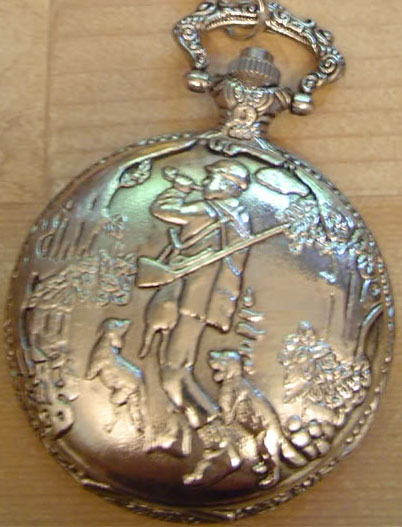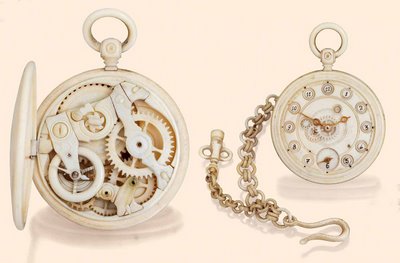|
 History of development of small-sized watches has started in the 16th century, and since then, until today, they constantly evolve. Invicta Swiss watch company has evolved simultaneously with advances in watchmaking. History of development of small-sized watches has started in the 16th century, and since then, until today, they constantly evolve. Invicta Swiss watch company has evolved simultaneously with advances in watchmaking.
Made in Europe in the 16th century, watches were rather small, and they could be worn in pockets. Of course, not the wrist, and there was a chain that hung around the neck or was attached to clothing. They were quite heavy, as the case was engraved and decorated with precious stones. In those days, in the first portable watches was minute and hour hands. Watches were made only with clockwise and face and hands were not covered with glass for protection, instead, was a brass hinged lid. Therefore, to determine the time the owner had to open the door of brass, unless the models were not of upper class, where the lid was engraved through, so the owner could see the time without opening the lid. Mechanisms in those days were made of iron or steel studs and sealed. It was so until 1550, when the screws were invented, and then they were used in the watch movements. But in fact, small-format first watch was useless as a time counter, as they showed significantly inaccurate time. People wore them more as a fashion accessory. In those centuries the watches were made in the shapes of such things as animals, flowers and crosses, which was more like a jewelry and fashion items, not watches itself, unlike the products of manufacturer Invicta, which is produced from the very beginning it was watches, the main function of which it was showing time. However, they were affordable.
In those days, just as the trend has changed in the clothes. King Charles of England in 1675 introduced the vest in men's fashion. These vests, of course, were with pockets and was no longer fashionable to have a big heavy watch hanging from his neck. Thus, a logical extension was to make watch movements become smaller and be done with the size of the pockets of these jackets. And indeed, as it turned out. Pocket watches became more rounded and flat, with no sharp edges or sides. The glass was first used to cover the watch dial in  1610. But, however, these models were not very good custodians of the time in connection with the so-called isochronism, because of which the clock slowed down considerably earlier than the margin of the main driving force - spring - came to an end. Hours have been continuously improved in appearance and size, but regardless of that, they were still very poor keepers of time, in contrast to the present day. So, the obvious next step was to improve the reliability of the reference time periods, and during the period between 1650 and 1765 was made a lot of inventions and improvements. In 1657 was invented a mechanism of balance and added to the balance wheel to operate the movement. The effect of this balance is the balance wheel made resistant to interference. Improvements over previous models was just phenomenal - some of the watches began to walk to within a few minutes a day. In this regard, a sharp improvement in the minute hand started to appear on the watch dial around 1700 in France. Watch manufacturers took note of the significant improvement of the movement due to the introduction of the balance wheel and tried to even greater improvement. Thomas Tompion in 1695 invented a cylindrical descent, which replaced the cut-slope, and quality in England expensive watches have become even use duplex descent, which was invented by Jean 1610. But, however, these models were not very good custodians of the time in connection with the so-called isochronism, because of which the clock slowed down considerably earlier than the margin of the main driving force - spring - came to an end. Hours have been continuously improved in appearance and size, but regardless of that, they were still very poor keepers of time, in contrast to the present day. So, the obvious next step was to improve the reliability of the reference time periods, and during the period between 1650 and 1765 was made a lot of inventions and improvements. In 1657 was invented a mechanism of balance and added to the balance wheel to operate the movement. The effect of this balance is the balance wheel made resistant to interference. Improvements over previous models was just phenomenal - some of the watches began to walk to within a few minutes a day. In this regard, a sharp improvement in the minute hand started to appear on the watch dial around 1700 in France. Watch manufacturers took note of the significant improvement of the movement due to the introduction of the balance wheel and tried to even greater improvement. Thomas Tompion in 1695 invented a cylindrical descent, which replaced the cut-slope, and quality in England expensive watches have become even use duplex descent, which was invented by Jean .jpg) Baptiste in 1724. In 1765, Pierre Le Roy came out with his invention of the wheel balance temperature compensation. The fact that he spent many years to discover that the balance of the wheel mechanism is exposed to changes in temperature. The elasticity of the springs varies with temperature fluctuations of the environment, so all the parts out of the synchronization process and make the loss of precision reference imminent. Therefore, the compensating balance wheel mechanism has been developed and refined by Thomas Earnshaw. As a result, hours are becoming even more accurate, the same as the first hours of the Swiss company Invicta. Baptiste in 1724. In 1765, Pierre Le Roy came out with his invention of the wheel balance temperature compensation. The fact that he spent many years to discover that the balance of the wheel mechanism is exposed to changes in temperature. The elasticity of the springs varies with temperature fluctuations of the environment, so all the parts out of the synchronization process and make the loss of precision reference imminent. Therefore, the compensating balance wheel mechanism has been developed and refined by Thomas Earnshaw. As a result, hours are becoming even more accurate, the same as the first hours of the Swiss company Invicta.
In the UK, in 1800, the trigger lever was invented by Thomas Magee and received considerable widespread use. That was the breakthrough that let him and was not one of the most significant improvements in the mechanism of a clock, but he had the undoubted advantage. And by 1900, the trigger lever was used in almost every new movement. The great advantage of the trigger lever was that it allowed balancer swing freely around the radius. Through this cycle, and due to blockage of hours were very accurate, matching the standards of today.
In the twentieth century it became the standard in construction of watches, and watch manufacturers  and first Swiss watchmaker Invicta applied to improve the design and production methods. Invicta used the best materials and made more stringent tolerances, improvings, in fact, the production of watches significantly. In the early twentieth century, wrist watches were worn mostly by women, not men, but in World War I soldiers were issued for a watch that will allow them to determine the time till their hands were engaged in the carriage and use of weapons, equipment and ammunition. and first Swiss watchmaker Invicta applied to improve the design and production methods. Invicta used the best materials and made more stringent tolerances, improvings, in fact, the production of watches significantly. In the early twentieth century, wrist watches were worn mostly by women, not men, but in World War I soldiers were issued for a watch that will allow them to determine the time till their hands were engaged in the carriage and use of weapons, equipment and ammunition.
1969 was a year when mechanical clocks were practically buried alive. It was the introduction of quartz watches that were just phenomenally accurate and inexpensive. Quartz crystal resonater replaced the traditional balance wheel and wathes were powered by batteries for the oscillator circuit. Since then it has moved to Invicta watch production with affordable and reliable quartz movement. The main advantage of quartz watches was that they were even more accurate, even with large changes in temperature, as well as a quartz watch is no longer a need for such work units, who were afraid of attacks. But the main advantage of a low cost movement that allowed the company Invicta fully implement its strategy — is to produce excellent watch for little money.
|
